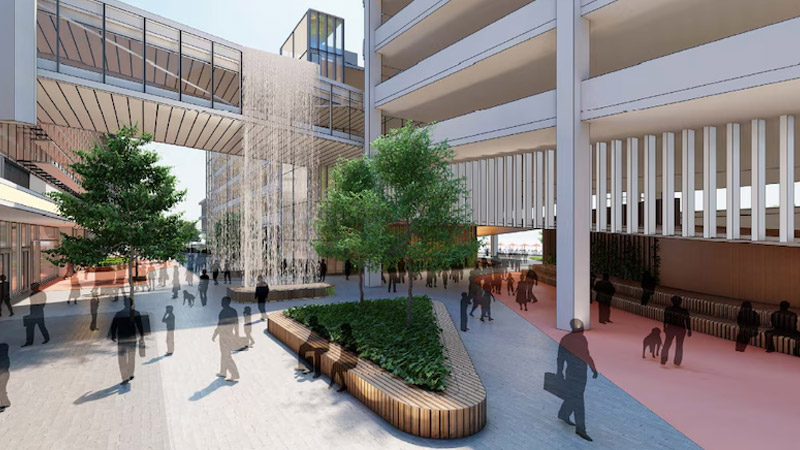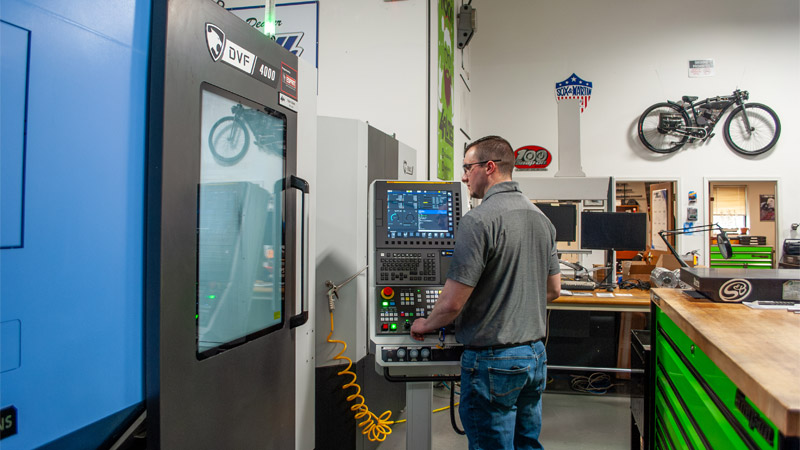Local leaders imagine the future of Southwest Michigan.
In 1929, the Swiss-born architect and urban planner known as Le Corbusier published a book titled “The City of Tomorrow.” It details the importance of supporting a city across each of its many sectors—from infrastructure to greenspace to technologies to social opportunity—to enable it to thrive.
In the book, Le Corbusier discusses “the right angle” for assessing practically any city. He encourages readers to step back and form a full perception of an area, considering how it existed in the past, how it’s changing now, and what might become of the place as the future turns to present.
From the ground in Southwest Michigan, it’s easy to look to the future and see the 35,000 jobs that will be left unfilled as masses of our current workforce reach retirement age over the next decade. This perspective becomes productive if, while we’re looking to the future, we also manage to form a vision for it—an agenda for growth. It’s productive if we look for the ways in which Southwest Michigan is poised for evolution and adaptation in terms of housing, technology, entertainment, education, and beyond—if we recognize how Southwest Michigan is being built for tomorrow.
“The future of Southwest Michigan will be defined by ideas that are translated into action,” says Jim Ritsema, city manager of Kalamazoo. “It’s a lot like all three of the cranes working along Kalamazoo’s skyline today.”
To a New Millennium
Ken Miller, CEO and principal partner of Millennium Restaurant Group, looks out his office window and smiles at the realization that his company—established in Kalamazoo just days before the turn of the century—is now nearly two decades old. He smiles still as he muses, “Downtown Kalamazoo was truly struggling in 1999. But now, we look into the city and see a life that didn’t exist there 20 years ago.”
In 1999, Southwest Michigan’s economy took several hits that resulted in steady decline for years thereafter. In the manufacturing sector alone, the region experienced an annual loss of 1,100 jobs—or 4.2 percent of the total market—for years, according to the U.S. Department of Housing and Urban Development.
“It killed me to watch what was happening, so I took a chance back then,” Miller says. “I started Epic Bistro, which was fairly upscale—a pretty edgy move at the time, considering the state of downtown [Kalamazoo].” Miller fielded criticism from what seemed like every direction. But all the same, Millennium Restaurant Group held on, and more developments began slowly popping up across Southwest Michigan.
The future of Southwest Michigan became steadily brighter across the board. The region began establishing one of the very first community-wide fiber networks in the nation. Activists worked toward the launch of the Brownfield Redevelopment Initiative in the late ‘90s, just as Western Michigan University (WMU) began its expansion into what would become its Parkview Campus. Soon, the region arrived at the early days of the Kalamazoo Promise.
However, growth is never without risk.
“Two years after Epic Bistro opened, we started the Union [Cabaret and Grille] down the street,” Miller reflects. “And today, I could hand you a list of probably 25 longstanding restaurants that exist that most people would never have dreamed of back in ’99. Looking back, I see that what [Millennium] did then was a risk. I can say that today because it’s all worked out pretty well; there’s life in the city again.”
Working on It
Today’s developments continue to build off of the risks taken at the turn of the century.
Julie Rogers, a Kalamazoo county commissioner, spends much of her time working to breathe even more life into Southwest Michigan—especially through her deep involvement with the region’s Brownfield Redevelopment Initiative. The movement aims to rehabilitate existing problem areas, including waste sites, vacant lots, and other properties throughout the region that are in need of improvement. Not only do these projects work to eradicate contamination across our communities, but they also serve to optimize the areas for attracting young professionals and new developments.
Although there is most certainly risk involved at every turn, there must be an inherent level of trust in the potential outcome of the investment. Rogers cites a current project of the Initiative’s—the Vicksburg Mill—and notes a major target for this particular project: young people.
“The Vicksburg Mill Redevelopment is a $60 million project that’s really quite visionary. We’re working to take this old, abandoned mill with various types of contamination and create not only a brewery but an outdoor music venue. Lots of college-educated people are leaving our region. But it’s projects like this—new, creative things, solutions for old problems—that will ultimately draw and keep people in our [region].”
The work done by the Brownfield Redevelopment Authority is similar to that of Imagine Kalamazoo 2025, an initiative that works to improve neighborhoods throughout our communities. Jim Ritsema explains the Foundation for Excellence-funded movement further, saying, “We’re working to pave roads, plant trees, improve greenspaces—make our neighborhoods cleaner and safer. Imagine Kalamazoo 2025 hopes to enhance the existing areas, shaping them into a place where people really want to live, work, and play.”
Rogers and Ritsema both hope that the projects being undertaken by Imagine Kalamazoo 2025 and the Brownfield Redevelopment Initiative will help foster a culture that attracts young people naturally. They need not only a reason to come, but also a reason to stay long-term—and fill the 35,000 jobs that will become vacant across the region.
An Integrated Place
Perhaps no one spends more time considering our region’s relationship to its young professionals than Dr. Jennifer Bott, provost and vice president for Academic Affairs at Western Michigan University.
“This region—this place—is what draws students [to WMU],” she says. “We talk a lot at WMU about our engagement with the community because Kalamazoo is the reason it’s possible for us to exist. Most universities are situated in towns where the industry and organization component is less-than-robust—where the university itself is the biggest employer in the area. But Kalamazoo, even without the universities, would be an incredible town. That’s such an opportunity for students and young professionals to step into.”
Through its Think Big Initiative, the university will adapt its branding to further integrate the school into the fabric of Southwest Michigan’s communities. “My wildest dream would be that the relationship that exists [between WMU and the community] would be so close that we’d be seen as a simple extension of one another,” says Bott. “For many of our students, the dream job is right here with one of the region’s dozens of thriving companies. It’s my hope that our students choose to stay in Kalamazoo and support the region that supported them.”
What we have here in Southwest Michigan is a booming economy and continued growth. Young people see that. They realize that, when it comes to life in our region, they’ll move forward with a return on their investment.”
An Infrastructure of Stability
Where Bott leaves off, CTS Telecom President and CEO Stacey Hamlin picks up. Southwest Michigan’s technological infrastructure serves as a backbone of sorts for the region’s growth trajectory.
As of 2019, only around 25 percent of communities in the country support community-wide fiber networks. In 1999, Southwest Michigan started on its way to becoming one of the first. “We’ve been building a fiber infrastructure [in Southwest Michigan] for over 20 years,” says Hamlin. “Not a lot of areas have a fiber network, although fiber is extremely powerful and creates an amazing foundation for growth, especially for large companies and municipalities.”
Hamlin looks forward to widespread use of drones, technologically-advanced municipal practices, and more benefits from this investment. “Southwest Michigan was among the first to take that plunge, and it’s proven to be a highly lucrative investment already—and the payoff is still gaining.”
Due to this effort—this calculated risk—Southwest Michigan has positioned itself as an elite area capable of drawing the attention of foreign investors. Companies in Germany, Japan, and elsewhere looking to outsource production commonly have a simple question: “What [technological] infrastructure do you have?” Southwest Michigan’s answer often pays off in the form of jobs—which means even more growth throughout the region.
A New Kind of Plan
When charged with the concept of envisioning an “agenda for growth” in the region, Dan Jaqua, owner and president of Jaqua Realtors, muses, “I struggle with what comes first; I do know that every bit of progress tends to spur on the next. If we create more jobs in the region, we boost quality of life. If we improve quality of life, we’ll create more housing to accommodate the people who have come to experience it—and so on. Everything tends to move in this cyclical manner because everyone is working to up their game along with [the sector] beside them.”
Many people—both within and beyond Southwest Michigan—hear talk of the impending addition of around 300 residential units to the downtown Kalamazoo area and perceive the movement as something of a gamble. Jaqua, however, counters, “These are calculated things. Sure, at face value, it’s a risk—but it’s also something we’ve needed for years in order to make Southwest Michigan into a place where people can and want to be.”
Jaqua explains, “The perception is that if we build it, they will come—and that will leave something else vacant. But that’s not what we’ve seen in our market. Instead, we see the primary market starting to grow. We’ve started to see people coming in, diversifying the demographic, upping the demand for housing as a whole.”
If there is to be an agenda for growth in our communities, as a region, we need to be willing to risk,” Jacqua says. “Without risk, there’s no reward. Without risk, there won’t be growth. In terms of housing, this means responding to the demands of the market. It means working toward things like lower building costs, taking calculated risks to allow for the desired changes that go well beyond housing.”
Through the Looking Glass
As Southwest Michigan pulls still farther away from where it was in 1999, local leaders look to the future and see a region characterized by risks that paid off.
The Southwest Michigan of tomorrow is a more physically beautiful area than ever, where, in Rogers’ mind, Brownfield sites have been rehabilitated and contamination has been largely eradicated.
It’s a place with fresh buildings, including, in Miller’s tomorrow, several boutique restaurants in the style of 600 Kitchen and Bar that appeal to foodies and lovers of drink from far and wide.
Jaqua anticipates a rush to the cities in response to new housing developments throughout the area, which will “fill major gaps in the market.”
For Hamlin, the region will enjoy “an economy in which current corporations continue to invest and new investors flock to take advantage of cutting-edge technology and overall quality of life.”
In Bott’s mind, higher education students will come for an education but stay for the ample opportunities for growth and leadership that the region’s communities offer.
By paying close attention to the needs of its people, and taking some risks, the Southwest Michigan region will continue to thrive.
“At the end of the day, this is the community that created the Foundation for Excellence and the Kalamazoo Promise—wild dreams that have already come true,” says Ritsema. “This region is a community that can act boldly and wisely in order to shape the best future possible.”




